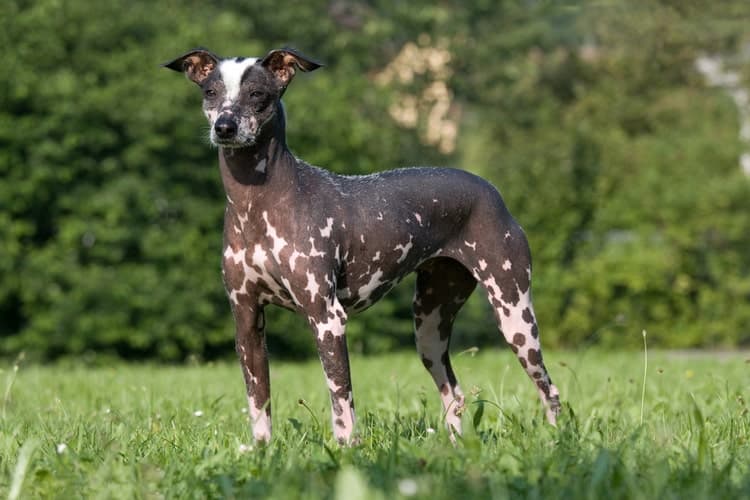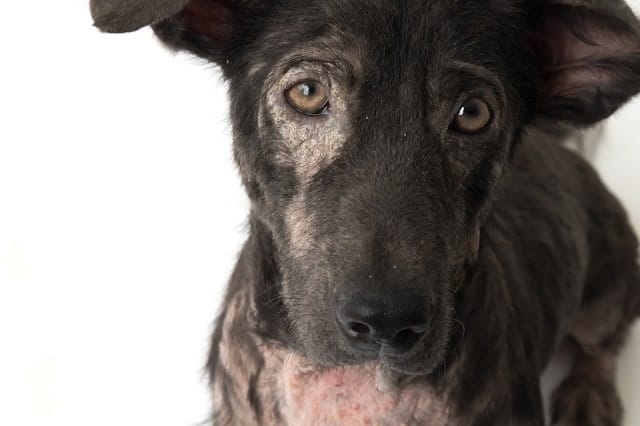
A dog’s hair coat is one of the first things that another person may notice about a dog. If your canine companion has a healthy, shiny coat, you’ve probably received lots of compliments from strangers or from the staff at your vet’s office. But what happens when your dog starts to lose hair in some areas? It can be pretty noticeable, especially if the hair loss is generalized and covers many parts of the body, and it can also indicate an underlying health issue. What are some things you should do to help your hairless hound?
Check Your Dog for Fleas
Flea infestations are one of the most common reasons why dogs can lose their hair. Fleas are tiny bugs that can jump on your dog and feed off of his blood. When fleas bite, their saliva can cause inflammation of a dog’s skin. This can be intensely itchy and may cause your pup to bite at himself. All these effects result in hair loss, which is most evident over a dog’s lower back. Hair loss in just this area alone is a classic presentation for flea allergy dermatitis.
Sometimes, it is easy to find evidence of fleas. They are small black or brown bugs that move quickly throughout the hairs on your dog’s skin. If he has a light-colored coat, fleas may be easy to find, but it can be difficult when your dog has a black hair coat. A thin-toothed flea comb is a useful tool because there is very narrow spacing in between the teeth, so it can pick up fleas easily. Another type of flea evidence is the presence of flea dirt, or flea feces. These look like little granules of ground pepper.
Consider Other Allergens in the Environment

Besides flea allergies, environmental allergies can cause hair loss. Your dog may be allergic to things outdoors such as pollen, grass, weeds, and trees. Even indoor allergens such as dust mites, storage mites, and molds can cause problems. In the same way the flea bites cause inflammation and itching, these indoor and outdoor allergens also cause a break down in the skin’s barrier.
You can think of your dog’s skin cells as bricks in a building wall, and the protective elements of the skin are the mortar that seals the spaces in between the skin cells. When inflammation occurs, it can affect the protective elements that seal the cells. Bacteria and other invaders can then get between the cells, causing infection.
Hair loss can occur due to damaged skin from allergens. This kind of hair loss can appear anywhere on the body. Food allergens may cause more generalized hair loss while some of the contact allergens from outdoors like grass will cause hair loss around the paws or belly.
Make an Appointment with Your Veterinarian
This is one of the most important steps because hair loss can be caused by so much more than just allergies and fleas. Mild allergies usually respond to antihistamines, and some fleas can be treated with over the counter topical products, but there are many more causes for hair loss. Some of these causes cannot be helped with over the counter treatments alone, which is why an immediate evaluation is so critical.
Certain kinds of skin parasites like scabies (aka Sarcoptic mange) can cause hair loss, intense itching, and can be transmitted to other pets and people. The same is true for fungal infections like ringworm, which can be acquired from other animals or from dirt and soil. Underlying hormonal disorders like Cushing’s disease, an adrenal gland disorder, and hypothyroidism are also possible. Your vet can perform skin testing and look at special blood tests to rule out some of these diseases. In these cases, hair loss may appear to worsen slightly before it gets better, and it can take weeks or months for your dog’s hair to regrow.
Check Your Dog’s Diet and Consider a Food Elimination Trial
A well-balanced diet is crucial to a healthy hair coat and skin. The vast majority of commercial dog foods are nutritionally complete diets, which means that they contain the right blend of the vitamins and minerals that dogs need in order to stay healthy. They also contain omega-3 fatty acids because, like humans, dogs cannot make their own omega-3s. These fatty acids are important for brain health, the health of the heart, and kidney function.
If your vet suspects that your pup has a food allergy, they will discuss switching diets in order to perform a food elimination trial. This means that your dog will need to eat a diet that is either novel in its protein source or the protein is hydrolyzed so that the immune system will not detect it and initiate a reaction. Since many omega-3 sources are fish oils, you may need to avoid any fish oil supplements during the trial.
Think About Trying an Omega-3 Supplement
Outside of food allergies, many dogs can benefit from omega-3 supplementation. There are many excellent products on the market, and they are generally safe to give to dogs of all ages. Omega-3s have been linked to the reduction of inflammation in many conditions, including skin disorders. They can also help dogs with chronic kidney disease, arthritis, and behavioral or brain disorders such as canine cognitive dysfunction in senior dogs.
Most veterinarians like me favor products that combine different elements. For example, Krillex Joint Formula is a supplement that I use for my own dogs and for many of my patients because it combines krill oil (an omega-3 source) with glycosaminoglycans. Glycosaminoglycans are complex sugars that are utilized in the development of cartilage and in the production of synovial fluid, a viscous fluid that lubricates a dog’s joints. Glucosamine, chondroitin, and hyaluronic acid are effective in helping dogs with inflammation and arthritis, and they are all included in Krillex’s formula.






